The truth that got fictionalised
In Woolf’s ‘Village in the Jungle’:
by Isuri Kaviratne
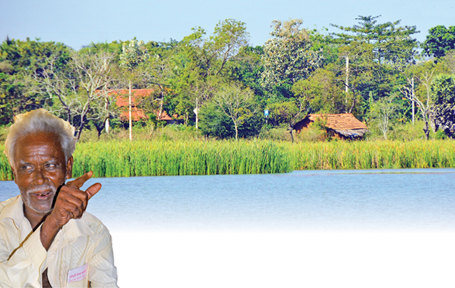 ‘No
jungle was more evil than the jungle which lay about the village of
Beddegama,’ writes Leonard Woolf in his epic opus ‘Village in the
Jungle’ juggling with the evil of the forest and the evil of the people.
Silindu, the protagonist of the story, fears the evil of the jungle and
overlooks the evil of the people, which Woolf successfully depict
throughout the story where Silindu ends up murdering two people;
Arachchi and Fernando. ‘No
jungle was more evil than the jungle which lay about the village of
Beddegama,’ writes Leonard Woolf in his epic opus ‘Village in the
Jungle’ juggling with the evil of the forest and the evil of the people.
Silindu, the protagonist of the story, fears the evil of the jungle and
overlooks the evil of the people, which Woolf successfully depict
throughout the story where Silindu ends up murdering two people;
Arachchi and Fernando.
Being the AGA of Hambantota from
1908 – 1911, Leonard Woolf travelled to the farthest corners of
Hambantota, meeting Silindus, Arachchis, Punchi Menikas and Hinnihamis
and many others who inspired him to write his epic. Over a hundred years
later, we trace the footsteps of Woolf and unearth some of the true
stories of the villagers from the depth of the jungle along the
Meegahandura Road, which was the base of ‘The Village in the Jungle.’
Story 1:
The Story of Silindu
He is known as Mudiyanse. Old and enjoying retirement, he relates the
story of Silindu, his great grandfather, who lived in Mal Asna Gal Wewa,
a small village along the Lower Mattala Road. It is not known whether
Mudiyanse’s great grandfather had the ‘slightly mad’ and ‘lazy’
characteristic of Leonard Woolf’s Silindu, but he inspired Woolf to
weave a story around the incident where Silindu was convicted of two
murders.
As Mudiyanse recounts, ‘trouble’ began when a new ‘Opisara’ was
appointed for the Upper Mattala Village. The new ‘Opisara’ considered
the powers of the longstanding ‘Opisara’ in Lower Mattala and his
father, the Registrar, who maintained a high regard among the villagers,
a threat to his new position. He hired Silindu to ‘take care’ of the
two, and gave his gun with a promise to save Silindu if he got caught.
Similar to ‘The Village in the Jungle’, where ‘all the families (in the
village) are closely related by marriage’, Mudiyanse says his family
tree includes Silindu as well as the ‘Opisara’ and the Registrar who
were murdered.
 As
narrated by Mudiyanse, Silindu lured the ‘Opisara’ of Lower Mattala out
of the house, pretending to get him to inspect his chena that was
destroyed by a herd of buffalos, and shot him en route in the thick
forest. On his way back, he stopped near ‘Opisara’s house, and shot the
Registrar, who was enjoying his morning tea, from afar and walked
straight to meet the ‘Opisara’ of Upper Mattala. As
narrated by Mudiyanse, Silindu lured the ‘Opisara’ of Lower Mattala out
of the house, pretending to get him to inspect his chena that was
destroyed by a herd of buffalos, and shot him en route in the thick
forest. On his way back, he stopped near ‘Opisara’s house, and shot the
Registrar, who was enjoying his morning tea, from afar and walked
straight to meet the ‘Opisara’ of Upper Mattala.
|
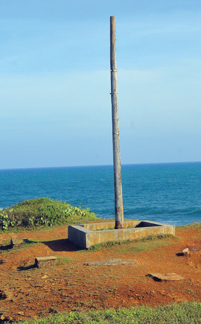
Remains of the gallows where criminals were hanged |
This story gets woven into ‘The Village in the Jungle’, where Silindu
murders Arachchi and Fernando in an attempt to protect his daughter,
Punchi Menika, and avenge the death of his other daughter, Hinnihami,
both of whom he was particularly attached to.
Mudiyanse says the tales he heard includes a side story where Silindu
meets the deceased Registrar’s brother on the way to Upper Mattala to
meet the new ‘Opisara’, but slips into the forest to avoid meeting him,
and even killing him, even though he had the chance.
The ‘Opisara’ of Upper Mattala had instructed Silindu to go to the
Hambantota Police station and surrender himself, and accordingly,
Silindu had walked approximately 40 kilometres to do so. Back then,
there had been a total of 12 police officers stationed at Hambantota
police and when Silindu walked in, only three had been present.
Mudiyanse’s family has a set of poems traditionally passed down in
the family, reminding the readers of Silundu’s sister and “the chants
peculiar to Karlinahami … who had learnt it from her mother.” They
believe that Silindu visited his wife, name unknown, before heading to
the police station and sang this to let her know of the poverty that
compelled him to commit ‘evil ‘deeds, demanding to know whether it
saddens her to see him going to prison.
“Silindu didn’t have any daughters. He had sons,” says Mudiyanse,
believing this to be the main difference between the fictional and real
Silindu.
The conversation between the police officers and Silindu, when he
confessed to the murders, is sung thus:
The police officers had initially been reluctant to accept Silindu’s
confession, and then assuming he had come to the police to kill them
too, had sent one officer to the Tangalle Police station asking for back
up. Mudiyanse recounts that the police has entertained Silindu to kill
time, agreeing with him on how hardships makes people vulnerable enough
to make wrong decisions, and had arrested him as soon as the backup
arrived from Tangalle.
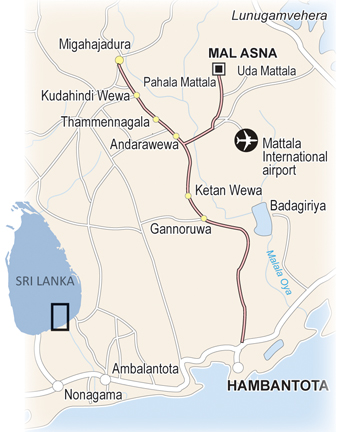 Little
is known about Silindu’s trial, but he had never returned home. The
family believes he was expelled to the Andaman Islands. Little
is known about Silindu’s trial, but he had never returned home. The
family believes he was expelled to the Andaman Islands.
Story 2:
Mal Asna Gal Wewa and Meegahajandura
Gun shots were common in the area as many used to hunt for food, “so
when my maternal grandparents heard the gun shots, they thought it was
hunters in the forest,” says V.G. Somarathne Vidanagama, a resident of
Lower Mattala. His grandparents’ families were two of the five families
in the village back then.
Recalling the stories he has heard from his grandparents, Vidanagama
says the Tamarind tree under which the ‘Opisara’ and his father were
buried is still there, but no one really knows which one it is. Being
the dry zone, the forest has many Tamarind trees. However, the two
Palmyra trees that marked the boundaries of the age-old village of Mal
Asna Gal Wewa are still intact, one tree adjoining the Gal Wewa lake,
which the villagers, including Silindu and his family, used to frequent.
The village still has ‘the jungle surrounding it, overhanging it,
continually pressing in upon it’. Through the village lies a footpath
that is currently used by farmers as a shortcut to their paddy fields,
the same path along which Silindu lured the ‘Opisara’ and murdered him,
and returned to kill the Registrar.
|
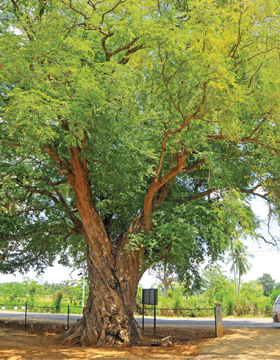
The Tamarind tree under which ad hoc court sessions were
held by Leonard Woolf to solve minor disputes among
villages, from 1908 to 1911, as the AGA of Hambantota.
(Pictures by Susantha Wijegunasekara) |
S.A. Munasinghe, a retired principle in Meegahajandura owns the land
with the massive Tamarind tree winged across the front lawn, providing a
cosy shady area in the otherwise scorching surrounding, as it must have
done a hundred years ago, when Woolf conducted hearings under it. “The
‘Vidane Aarachchi’ back then was my late wife’s grandfather, Don Samuel
Nallaperuma, and we have heard many stories about the ‘sudu mahattaya’
coming to our village to solve disputes”. He admits that the only murder
case they’ve heard of in the area back then was the story of Silindu.
Leonard Woolf, Munasinghe has heard, used to come on a horse,
surrounded by village kids who tried to keep up with the horse.
Following the horse was a cart that carried Woolf’s necessities. They
would arrive at the Tamarind tree in their garden, where Woolf used to
listen to minor complaints and solve disputes. There had been a small
cage made of wood and a ‘Dandu Kanda’ for immediate punishments.
Most of the cases he heard under the tree had been about avoiding
taxes, marriage disputes, and gun permits. Many of them would be solved
the very same day. Others had been transferred to the Hambantota Court,
compelling the complainers and defendants to walk over 40 kilometres to
Hambantota town for the court hearings.
Story 3:
A hundred or so years later
‘The smell of hot air, of dust, and of dry powdered leaves and
sticks’ are still characteristics of the pockets of villages that
eventually became the inspiration of ‘The Village in the Jungle’. The
jungle that glided into Punchi Menika’s doorway has been cleared in
pockets; villagers have fought back the ‘evil’ jungle and burnt it to
clear lands for agriculture. Many of the villagers are encroachers and
had settled in the area recently. In the old families, the youth have
little knowledge of the ancient stories, and the elderly are too old to
remember the interesting facts.
The development in the area is indicated by the carpeted main road
from Hambantota to Meegahajandura, constructed recently as an addition
to Mattala Airport. But a peek inside the villages reveal small by-lanes
and footpaths that stretch for miles along the pockets of forests that
are yet to be cleared, resonating Woolf’s words ‘trees and bushes which
knit the whole jungle together into an impenetrable tangle of thorns’.
It is easy picture the image Woolf had when he wrote ‘If you walk all
day through the jungle…, you will probably see no living thing’.
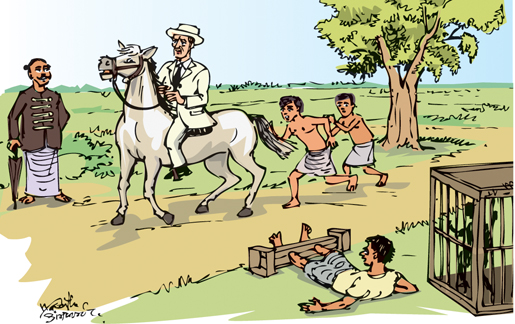 Though
the main occupation of the villagers is paddy cultivation, Woolf wrote
‘they only cultivated rice about once in ten years’ due to lack of rain.
People are still struggling due to lack of water and manage a meagre
harvest in one season, and shift to chena cultivation for the rest of
the year. J.K. Channaka of Ketan Wewa village says drinking water is
being distributed by the Municipality Council. Though this is the
situation from Gonnoruwa to Meegahajandura, due to reconstruction of Mau
Ara canal in the late 1990s, paddy cultivation has improved in
Meegahajandura. Here, people have better houses, many own motorcycles or
three-wheelers, some even own a car, and the dryness that is visible
just two kilometres south from the village seems to have evaporated. Though
the main occupation of the villagers is paddy cultivation, Woolf wrote
‘they only cultivated rice about once in ten years’ due to lack of rain.
People are still struggling due to lack of water and manage a meagre
harvest in one season, and shift to chena cultivation for the rest of
the year. J.K. Channaka of Ketan Wewa village says drinking water is
being distributed by the Municipality Council. Though this is the
situation from Gonnoruwa to Meegahajandura, due to reconstruction of Mau
Ara canal in the late 1990s, paddy cultivation has improved in
Meegahajandura. Here, people have better houses, many own motorcycles or
three-wheelers, some even own a car, and the dryness that is visible
just two kilometres south from the village seems to have evaporated.
J.B. Dingihamy and K.G. Sedarahamy of Gonnoruwa say the only
transport available at the time they arrived in the area in 1970 was a
bullock cart to go to Hambantota. Currently, there is a bus service on
the main road, every 90 minutes. Though there are primary and secondary
schools every three to four kilometres along this stretch, people have
to travel 20-30 kilometres to the Hambantota hospital in cases of health
emergencies.
Sujith Prasanna¸ a resident of Lower Andarawewa says when he first
arrived in 1983; there were only bullock carts, and one van to transport
people. But “we have to carry a ‘keththa’ with us to clear the forest
for the van to move through.” His words draw uncanny similarities to
Woolf’s description of people carrying ‘keththas’ to clear the jungle
when travelling in carts.
Being a farmer, Prasanna says lack of rain has left him with no
occupation. “I’m willing to do any work that will get me some money for
my three kids,” he says, bringing to mind another reminder of Silindu’s
tale. |

